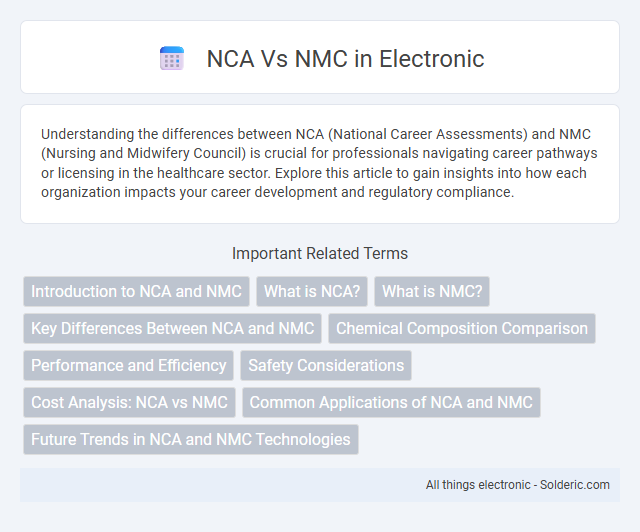Understanding the differences between NCA (National Career Assessments) and NMC (Nursing and Midwifery Council) is crucial for professionals navigating career pathways or licensing in the healthcare sector. Explore this article to gain insights into how each organization impacts your career development and regulatory compliance.
Comparison Table
| Feature | NCA (Nickel Cobalt Aluminum) | NMC (Nickel Manganese Cobalt) |
|---|---|---|
| Chemical Composition | Nickel, Cobalt, Aluminum | Nickel, Manganese, Cobalt |
| Energy Density | High (up to 250-300 Wh/kg) | Moderate to High (200-250 Wh/kg) |
| Cycle Life | Good (1500+ cycles) | Better (2000+ cycles) |
| Thermal Stability | Moderate | Better thermal stability |
| Cost | Higher due to aluminum and cobalt | Lower, widely used and cost-effective |
| Common Applications | Electric Vehicles, Aerospace | Electric Vehicles, Portable Electronics |
| Safety | Moderate, risk of overheating | Improved safety and stability |
Introduction to NCA and NMC
NCA (National Construction Authority) regulates construction standards and enforces compliance within the industry, ensuring safety and quality in Kenya's built environment. NMC (Nursing and Midwifery Council) governs nursing and midwifery practices, focusing on professional conduct, training accreditation, and licensing in the health sector. Understanding the roles of NCA and NMC helps you navigate regulatory frameworks relevant to construction and healthcare professions.
What is NCA?
NCA, or Nickel Cobalt Aluminum oxide, is a type of lithium-ion battery cathode material known for its high energy density and long lifespan, making it ideal for electric vehicles and portable electronics. This cathode combines nickel for increased capacity, cobalt for stability, and aluminum for enhanced safety and cycle life. Compared to NMC (Nickel Manganese Cobalt), NCA typically offers higher energy density but may require more robust battery management systems to ensure stability.
What is NMC?
NMC, or Nickel Manganese Cobalt oxide, is a popular lithium-ion battery cathode material known for its balanced energy density, thermal stability, and lifespan. Compared to NCA (Nickel Cobalt Aluminum oxide), NMC offers superior safety and cost-effectiveness, making it a preferred choice in electric vehicles and portable electronics. Your battery performance can benefit from NMC's optimized blend of metals, which enhances capacity without compromising reliability.
Key Differences Between NCA and NMC
NCA (Nickel Cobalt Aluminum) and NMC (Nickel Manganese Cobalt) are two common lithium-ion battery chemistries with distinct characteristics. NCA offers higher energy density and longer lifespan, making it suitable for electric vehicles requiring extended range, while NMC provides better thermal stability and enhanced safety due to its balanced manganese content. Understanding these key differences allows you to select the optimal battery type based on performance priorities such as energy capacity, safety, and cost-efficiency.
Chemical Composition Comparison
NCA (Nickel Cobalt Aluminum) and NMC (Nickel Manganese Cobalt) batteries differ primarily in their metal ratios, where NCA typically contains about 80% nickel, 15% cobalt, and 5% aluminum, while NMC usually has a balanced mix such as 60% nickel, 20% manganese, and 20% cobalt. The high nickel content in NCA enhances energy density but reduces thermal stability compared to NMC, where manganese improves structural stability and safety. These variations in chemical composition directly influence battery performance, lifespan, and application suitability in electric vehicles and energy storage systems.
Performance and Efficiency
NCA cathodes deliver higher energy density and superior thermal stability, enabling longer battery life and improved safety in electric vehicle applications. NMC cathodes offer balanced performance with excellent power output and cost efficiency, making them versatile for a wide range of energy storage needs. Your choice between NCA and NMC depends on whether peak energy capacity or overall economic efficiency takes priority in your application.
Safety Considerations
NCA (Nickel Cobalt Aluminum) batteries offer higher energy density but present increased thermal runaway risk compared to NMC (Nickel Manganese Cobalt) batteries, which provide enhanced thermal stability and safer performance under stress. NMC chemistry's balanced composition reduces overheating and improves cycle life, making it a preferred choice for applications prioritizing safety. Your safety considerations should weigh NMC's lower flammability and better temperature tolerance when selecting battery technology.
Cost Analysis: NCA vs NMC
The cost analysis between NCA (Nickel Cobalt Aluminum) and NMC (Nickel Manganese Cobalt) lithium-ion batteries highlights significant differences in material expenses and overall pricing. NCA batteries generally have higher nickel content, which can increase raw material costs, whereas NMC batteries balance nickel with manganese and cobalt to optimize cost-efficiency and performance. Your choice between NCA and NMC should consider these cost factors alongside energy density and application requirements.
Common Applications of NCA and NMC
NCA (Nickel Cobalt Aluminum) and NMC (Nickel Manganese Cobalt) lithium-ion batteries are widely used in electric vehicles and energy storage systems due to their high energy density and long cycle life. NCA batteries are preferred in applications demanding high energy and power, such as Tesla electric cars, while NMC batteries are favored for a balance of safety, cost, and performance, making them common in portable electronics and grid storage. Your choice between NCA and NMC depends on specific requirements like energy capacity, longevity, and cost-effectiveness for the intended application.
Future Trends in NCA and NMC Technologies
NCA (Nickel Cobalt Aluminum) and NMC (Nickel Manganese Cobalt) battery technologies are advancing rapidly to meet the demands of electric vehicles and energy storage systems. Future trends indicate enhanced energy density and cycle life, with NCA focusing on higher nickel content for greater capacity and NMC evolving through variations like NMC 811 for improved thermal stability and cost efficiency. Researchers are also exploring solid-state electrolytes and recycling methods to boost sustainability and performance in both NCA and NMC batteries.
NCA vs NMC Infographic

 solderic.com
solderic.com